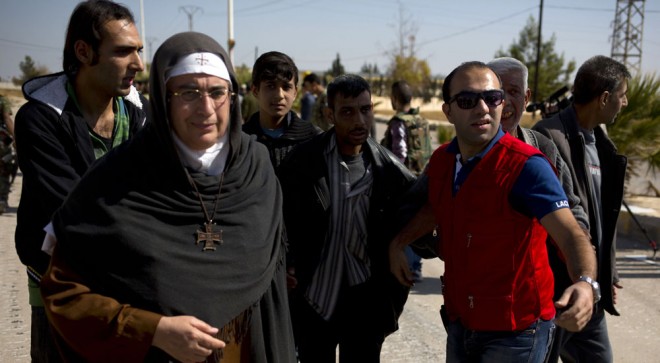
In this Oct. 29, 2013 photo, Mother Superior Agnes-Mariam Of The Cross walks with people fleeing the rebel held suburb of Moadamiyeh to the government held territory in Damascus, Syria. Amid Syria’s brutal civil war, a nun has emerged as an unlikely power broker and figure of controversy. Mother Superior Agnes-Mariam of the Cross has thrust herself into the role of go-between and publicist, arranging cease-fires, organizing pro-government media trips and conducting speaking tours as perhaps the country’s most prominent critic of the uprising against President Bashar Assad. AP
BEIRUT, Lebanon—Amid Syria’s ferocious civil war, a nun has emerged as an unlikely power broker and figure of controversy.
Mother Superior Agnes-Mariam of the Cross has thrust herself into the role of go-between and publicist, arranging cease-fires, organizing pro-government media trips and conducting speaking tours as perhaps the country’s most prominent critic of the uprising against President Bashar Assad.
Anti-government activists scathingly call her “Assad’s nun” for claiming a chemical attack that killed hundreds was exaggerated, and for saying rebels used kidnapped babies in massacres that were blamed on Syrian forces.
She is so despised by the opposition that even acts of seeming goodwill are criticized, such as arranging a rare truce that allowed thousands to leave a blockaded town.
Supporters see her as a brave truth-teller, and she reflects the fears of many Syrians who worry that hard-line Muslim rebels trying to overthrow Assad will make life intolerable for Christians and other minorities.
The nun insists she is not an Assad propagandist, describing his family’s decades-long hold over Syria as a “tumor,” but she saves her harshest criticism for the rebels.
“The rebels presented themselves as the doctor who will remove this tumor,” she said in a recent Skype interview. “They imposed arms as a treatment, and it is killing Syria.”
Agnes-Mariam, 61, was born Fadia Laham in Lebanon to Palestinian Christian refugees. In the social upheaval of the ’60s, Laham was a self-described hippie and trekked to Nepal on what she called a spiritual journey that led her to Catholicism.
She moved to Syria two decades ago, establishing a new order within the Greek Catholic Church, The Unity of Antioch, and founded the St. James convent 55 miles (90 kilometers) north of Damascus.
The nun was skeptical of the 2½-year-old Syrian uprising from the start.
She claimed much of the footage of anti-Assad demonstrations posted to social media networks was faked, along with video of Syrian forces beating and killing protesters
The Syrian government heavily restricts foreign reporting on the fighting. But Agnes-Mariam organized pro-government media tours, using her connections to obtain visas for journalists.
During a January 2012 tour, French TV reporter Gilles Jacquier was killed in a mortar attack in the city of Homs. Officials said he was killed by rebels, while reporters accused the government. Agnes-Mariam said she was unfairly blamed.
In May 2012, after Assad-loyal forces massacred dozens of Sunni men, women and children in the Houla region, she claimed the slain children were Alawites — members of Assad’s sect — who had been kidnapped by rebels.
She made a similar claim after hundreds of civilians were killed in a chemical attack on rebel-held suburbs of Damascus on Aug. 21. In a 50-page report, she said the children were probably kidnapped because their mothers weren’t in the videos that activists uploaded to YouTube. She also claimed some videos were faked so victims would appear more numerous.
Her report was cited by Russia’s foreign minister to cast doubt on claims that Assad forces perpetrated the attack.
Peter Bouckaert of Human Rights Watch said Agnes-Marie’s allegations were “based on bizarre theories about bodies being moved.” He said it is normal for the bodies of men and women to be separated so that they can be ritually washed according to Islamic custom.
Most recently, Agnes-Mariam surprised reporters in late October by appearing in her black habit and white wimple outside the rebel-held town of Moadamiyeh, where she brokered a truce allowing residents to be evacuated from the besieged area.
Agnes-Mariam said she got involved after seeing photographs of starving Moadamiyeh children on her Facebook feed. “I said, ‘This doesn’t happen in Syria,'” she said.
The nun contacted other government and security officials she knew from decades of interfaith outreach. She said she gradually built up her connections through her “pushy” personality and constant lobbying, saying people found it hard to refuse a nun.
The truce failed several times, but over a series of days, some 5,000 people were evacuated.
Activist Qusai Zakariya, however, accused of nun of breaking her word by allowing Assad’s security forces to seize men suspected of being armed rebels as they left. Zakariya said she bears responsibility for their fate if they were tortured or killed in custody.
The nun said the men were taken to determine their status as civilians or fighters. She said that two men disappeared but that volunteers were trying to locate them.
George Kallas, an official at the Beirut-based Greek Catholic Patriarchate, which oversees Agnes-Mariam’s convent, would not comment directly on her work and said her statements do not reflect the opinion of the Greek Catholic Church.
Agnes-Mariam is now on a speaking tour of the U.S., Canada and Britain. But she withdrew from an anti-war conference in London this weekend after other speakers threatened to quit if she participated.
In Britain’s weekly Spectator, one writer called her “the Syrian equivalent of one of Hitler’s brown priests.” Bouckaert of Human Rights Watch said she “abuses her religious status to spread her lies.”
To others, she is a humanitarian who is informing the West by correcting biased media reporting.
“She is searching for the truth about what is happening in Syria,” said Damascus-based freelance reporter Safa Mohammed.
For her part, the nun said she is doing her flawed best.
“I am not the awaited-for Messiah,” she said. “I am trying to work as a human.”